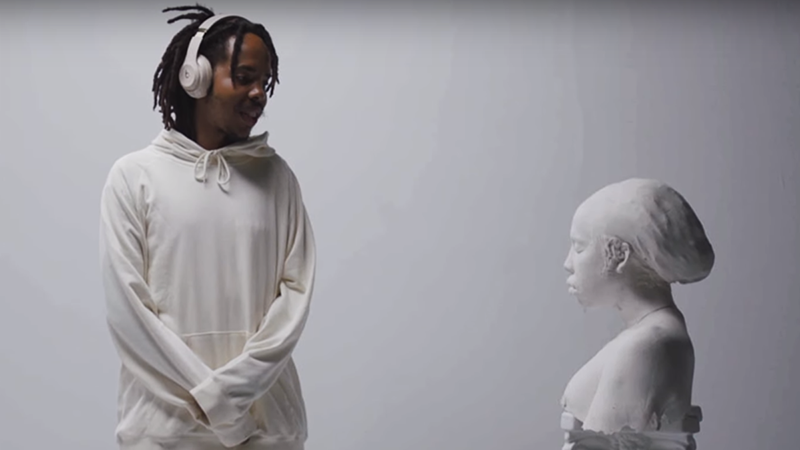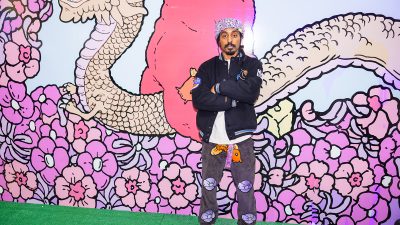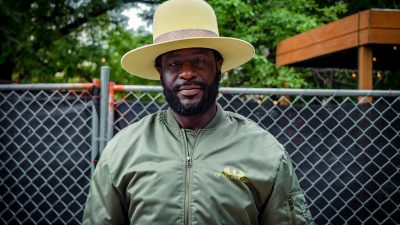Imprecise words on “Nowhere Nobody” by Earl Sweatshirt: Reconstruction of race and gender

by Alec Berton
Earl Sweatshirt’s new video, “Nowhere Nobody,” delivers dense imagery to explore personal themes of gender and race. The video contains clips from seven of his songs from his latest album Some Rap Songs. The album and video continuously ponder the phrase “imprecise words,” a sample of author James Baldwin who, like Earl, questions the potency and accuracy of language and the responsibility of artists in society. Acknowledging his own subjectivity and the limitations of language, Earl creates an experience full of visual allusions and metaphors to investigates the relationship between life and representation.
The dissonance between different forms of representation in this piece speaks volumes through the beautiful work on screen. During the song “Red Water,” a mother paints a ceramic baby green in a crib in Earl’s home before the landscape changes to what appears to be an art gallery. Juxtaposing personal life with a capitalized spectacle in a gallery creates tension. At this point a message flashes on the screen, “a CDC report in December 2013 found that black fathers were the most involved with their children on a number of measures of any other group of fathers.”
The visuals of the mother and child with this message force the viewer into a state of contemplation. The message does not relate to this child. The personal truth does not sync with the public’s. The dissonance in understanding serves as a catalyst to show that these dissonances are real and impact the forming of identities all the time. Whether it is race being portrayed in certain ways or gender, these dissonances in ourselves can cause many struggles. In this case, for a single black mother and child, as well as how they are seen.
Understanding that art and representation serve as some building blocks in the way we understand ourselves and the world around us, Earl attempts to find a true ethos of identity. This is incredibly difficult, for the fact that all representation has been manufactured by someone. Earl peels back ivy off a black body with ceramic white hands searching for something natural amidst all the representation, as well as he is finding a ceramic body under the ivy, something unnatural underneath the natural world. This distinction between natural and unnatural is, of course, a man-made construction the same way art is, and race or gender. Whiteness is as much a construction as blackness – a construction that cyclically defines themselves in relation to the other, the way Earl’s hands control the white ceramic hands that clear the ivy that reveal the body.
As much of a construction race and gender are, that is not to say that representation is not important. Quite the opposite. Earl handles these issues in such an eloquent way that shows a genuine approach to his message. One example of this is during “Azucar.” Earl and a woman looking similar to Earl are mirroring each other inside Earl’s home. When the lyric, “There’s not a black woman I can’t thank” comes up, the environment switches to the gallery in which Earl is standing in front up with the two women of the video sitting with their backs to the camera. This juxtaposition between the private and the public shows just how phony the art world and the world of representation can be by having the woman he’s thanking watching him like he’s a spectacle while they are not worthy of any representation. At this point, another message comes across the screen informing us this is, “an a-solmenic portrait of a black woman with whom you engage in mutually tempered pushback.” This caption further pushes the viewer to investigate beyond representation. What was once seen as a boy and girl mirroring each other could now be seen as an argument. The two sides of representation arguing and competing for dominance of rhetoric.
Earl constructs his art to have these modes of representation compete to the point where the viewer must look deeper than what is right in front of them. Earl takes these perspectives of whiteness and blackness, male and female, and turns them on their head to reveal to the fragility of these structures. Our history has become as permanent as ceramic sculpture, but with the proper push and pull, these structures that form us can shatter leaving room for us to rebuild and re-understand ourselves and the world around us. Earl Sweatshirt or should I say Thebe Kgositsile is an artist that isn’t afraid to create a language that can change the world.













